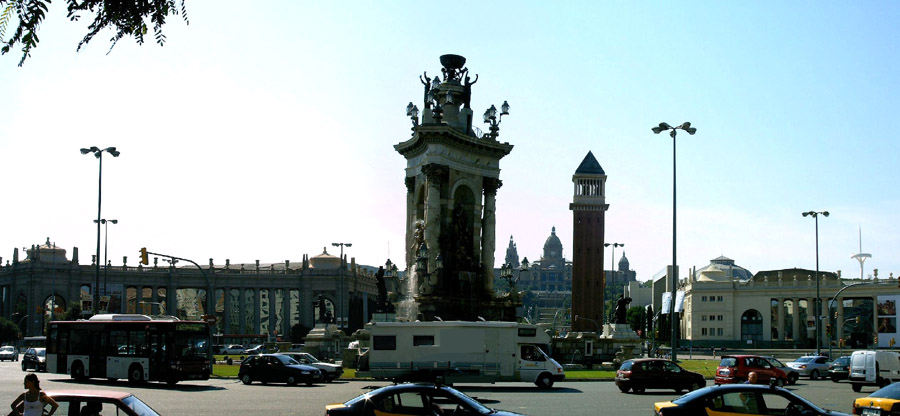Plaça d'Espana
The 4th day was the first
day we walked to the west at Gran Via towards Placa d´Espana. This place is approximately
as far to the west from our hostal as Placa Catalunya is to the east (10min walk).
After visiting Parc Industrial d' Espana and Estacio Sants, we walked back towards
the south and Placa d´Espana. The six blocks felt very long in the heat. Now,
we will look closer on Placa d' Espana.

Placa d´Espana is a very trafficated roundabout, so the place is not so nice itself,
but there are outstanding monuments surrounding it.
It doesn´t became less impressive with the fact that there is a large, beautiful
fountain in the middle, more fountains to the north of the square and nearby skyscrapers.
The
2 spires of Placa d'Espana, inspired by the San Marco Campanile in Venice. They
are characteristic monuments that can be seen from the whole area.
Looking towards Placa d'Espana with Palau Nacional, the spires, Catalunya
Plaza Hotel.
Las
Arenas. This former bullfighting arena from 1899 is under reconstruction. Some
glass sections will be added and the arena will be converted to a commercial center
(look at the illustration) because most Catalans don't like bullfighting.
Avenida
de la Reina Maria Cristina begins at Placa d'Espana. It is a short avenue
that is edged by the most magnificent exhibition halls from Fira Barcelona, the
world exhibition in 1929. The avenue leads to the beginning of the mountain Montjüic that can be see through almost the whole Barcelona. Different levels of stairs
and two escalators leads to Palau Nacional, an impressive building in classic
style that contains Catalonia's national art museum. In the middle of the stairway
are splendid water falls. When you have walked the first stairs to Palau Nacional,
you can see Font Magica, an incredible fountain is changing colours accompanied
by opera music after 8P.M. Sadly, at daytime the water is off.
Palau de Congressos. One of the congress palaces from the world fair at Av. de
la Reina Maria Cristina.
Palau Nacional. This domed palace from the world fair in1929 contains Museu
Nacional d´Art de Catalunya, the historic art museum of Catalonia. It contains
one of the world´s largest art collection from the middle ages, works by such
famous artists as Rembrandt and Zurbarán, and reconstructed interiors of churches.
You can read about the proceeding of this day in the Montjüic section, as we reached this mountain after climbing the stairs.
As a summary, this 4th day was the most incredible day on our Barcelona trip! At least if you count the evening when we visited Placa d'Espana and the fantastic "magic fountain" in the evening, that performed an incredible light and music show. The fountain is called Font Màgica and flushes in pink, yellow, white, orange, blue and green with different amounts of water and different rhythms to the tones of Freddie Mercury's "Barcelona" (unfortunately not the evening we were there) and other opera songs. Font Màgica is situated at the end Avenida Reina Maria Cristina at the foot of Montjüic were the stairs to Palau Nacional begins. The avenue is also bordered by lightened fountains. The fountain in the middle of Placa d'Espana and Palau Nacional's water fall are also lit by night.
Font Màgica was designed by Carles Buigas for the 1929 world fair.
The cascade is at most
15 m high. As you can see, many people are crowded to see the spectacle. Note
that Temple Expiatori del Sagrat Cor is lightened in gold colour after dark!
We didn't take any photos the very last day. We were leaving in the early evening, were almost broke and didn't have more energy to walk and take pictures in the hot sun. This day we decided to go to the harbour and have a siesta for the first time!